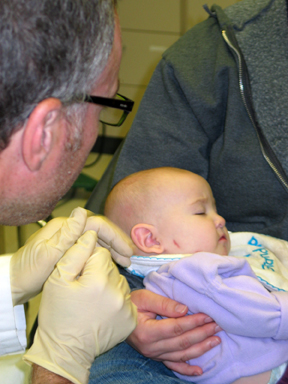 |
Weeks after the jaw lengthening procedure, Michael Miloro, D.M.D., M.D., sees a sleeping Kieli Rauert. |
She gums the sky-blue trim on her “I love my grandma” bib and nibbles on her baby-soft fingers.
When she turns, you notice two small pink scars on either side of her jaw.
What you don’t see is how physicians at UNMC used tiny screws to lengthen Kieli’s jaw 4 centimeters – not quite the length of a large paper clip.
The Cairo, Neb., infant was born with Pierre Robin syndrome, a relatively common birth defect that occurs in nearly one out of 8,000 births. Two defining characteristics of this syndrome are micrognathia or “small jaw,” and a cleft soft palate.
“We knew she had a cleft palate,” said her mother, Tina Rauert. “But initially we couldn’t tell anything was wrong with her jaw. At one month we could tell she had no chin or jawline on her lower mandible.”
The structural abnormalities can cause the infant’s tongue to be pushed so far back in the throat the baby can’t swallow, or even breathe, without assistance. In the most severe cases, the infant requires a tracheostomy, or tube placed in the neck to allow unimpeded breathing.
 |
Kieli Rauert dons the distraction device to lengthen her jaw. |
The treatment is called jaw distraction osteogenesis, and Dr. Miloro says it provides a long-term solution to, and is a solid improvement over a tracheostomy.
“Jaw distraction is a permanent solution to micrognathia, and it has several advantages over a tracheostomy, which is a riskier option, and does nothing to correct the small jaw,” Dr. Miloro said.
“A tracheostomy carries a mortality rate of up to 5 percent, even at major centers,” he said. “And while it creates a temporary solution to the infant’s breathing problem, it has to remain in place for up to two years or more. During that time the baby must be fed by a gastric tube and experiences delays in speech and language development.”
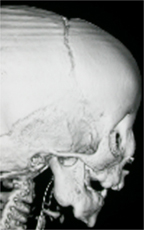 | 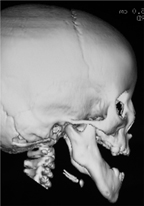 |
A person prior to jaw distraction osteogenesis. | The results of the jaw-lengthening procedure. |
During jaw distraction surgery, Dr. Miloro makes a partial cut through the jawbone, behind the last developing baby tooth. A portion of the bone marrow and blood vessels in this bone are preserved to support new bone growth that will occur during the distraction process.
Two titanium rods — 5/64 of an inch or the size of pencil lead — are surgically placed through the baby’s upper and lower mandible, and then tiny distraction devices are attached to the rods during the surgical procedure. These external distraction devices are turned a few millimeters each day to gradually lengthen the porous jawbone in the area where the cut was made in the bone. Jaw distraction not only removes the need for tracheostomy, it lengthens the jawbone to normal size within weeks.
In Kieli’s case, physicians lengthened her jawbone 4 centimeters over the course of approximately 10 days.
It made a significant difference for the little girl whose birth defect had caused her tongue to block her airway, and sent her to Omaha by medical helicopter hours after being born on April 4, 2005. She had to be tube fed and was sent home with an oxygen and apnea monitor. “We carried oxygen even if we went to the store for 20 minutes,” her mother said.
Kieli’s father, Steve, and Tina met Dr. Miloro while being fitted for a cleft palate shield obstructor at UNMC. Kieli’s one-hour surgery to insert the titanium rods took place June 13, at The Nebraska Medical Center.
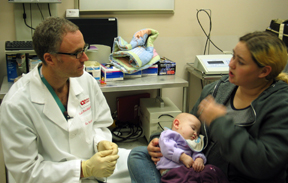 |
Young Kieli Rauert sleeps while Dr. Miloro talks with her mother, Tina, during a recent visit. |
Today, Kieli is all smiles, even though she still faces future surgery including repair of her cleft palate. “She’s a lot happier,” her mother said. “She seems more content and chews on her toys. Before the operation she had to be tube fed and had no idea things could go in her mouth.”
Dr. Miloro has performed jaw distraction osteogenesis on infants as young as 5 days old. He also has trained health professionals and surgeons in Mexico, where there is an increased incidence of cleft lip and palate; donated the expensive distraction devices to Mexican physicians; and treated about a dozen patients throughout Mexico.
Dr. Miloro also has performed several dozen cases of distraction osteogenesis for babies in the neonatal period, in order to avoid or remove a tracheostomy, which had already been placed for severe airway obstruction. In every case, he said, successful prevention or removal of the tracheostomy has been achieved and the babies have not had any airway difficulties after surgery. In addition, their feeding tubes were discontinued and the patients were using a bottle within days to weeks after surgery.
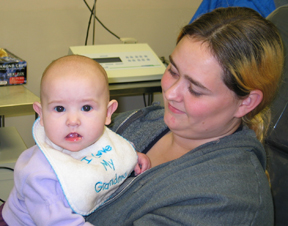 |
Kieli Rauert and her mother, Tina, wait to see Dr. Miloro. |
“It’s not an easy question to answer,” he said.
Pierre Robin patients may have an “inherent” deficiency of jaw growth, he said, that may manifest itself later in life and require a routine lower jaw advancement procedure. This is typically done in the adolescent period following orthodontic therapy, he said.
“It is possible, however, that surgical correction of the small lower jaw deformity early in life will allow a normal growth of the lower jaw along with the growth of the upper jaw,” Dr. Miloro said. “In either case, the immediate problem of airway obstruction is resolved and these babies are able to function normally and have a normal early psychosocial and speech development pattern. With regards to long-term growth, only time will tell.”